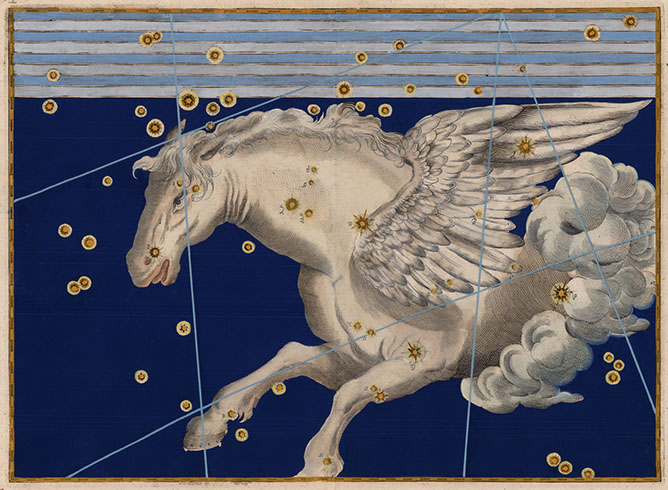Pegasus: The Winged Horse
Pronunciation: PEG-us-us
| Pegasus Constellation Profile | |
|---|---|
| Abbreviation: Peg | Genitive: Pegasi |
| Origin: Ancient | Location: Northern Hemisphere |
| Best View (North): Autumn | Best View (South): |
| Bordering Constellations: Lacerta, Cygnus, Vulpecula, Delphinus, Equuleus, Aquarius, Pisces, Andromeda | |
The Myth Behind the Constelltion Pegasus
Pegasus was the winged-horse that sprang from the blood of Medusa when Perseus cut her head off. He served as Perseus’ steed and helped the hero defeat the sea-monster Cetus to save Princess Andromeda and the country of Aethiopia. Athena took Pegasus to Mount Helicon, the mountain of the muses, where with a single kick of his hoof started the flowing of the famous spring of Hippocrene, said to be the source of all poetic inspiration.Pegasus Constellation Points of Interest
| Interesting Objects in the Constellation Pegasus | ||||
|---|---|---|---|---|
| Name | Messier | NGC | Type | Visibility |
| M15 | NGC 7078 | Globular Cluster | Binoculars | |
Bright Stars in Pegasus
These are the stars in Pegasus with a minimum magnitude of 3.0.| Name | Bayer Name | Magnitude | Color | Luminosity | Distance |
|---|---|---|---|---|---|
| Enif | Epsilon Pegasi | 2.38 | Orange | 26,203 suns | 673 ly |
| Scheat | Beta Pegasi | 2.44 | Red | 3,878 suns | 199 ly |
| Markab | Alpha Pegasi | 2.49 | Blue-White | 193 suns | 140 ly |
| Algenib | Gamma Pegasi | 2.83 | Blue | 2,564 suns | 333 ly |
| Matar | Eta Pegasi | 2.93 | Yellow | 327 suns | 215 ly |